Knowde Enhanced TDS
Identification & Functionality
- Chemical Family
- Chemical Name
- INCI Name
- Ingredient Origin
- CASE Ingredients Functions
- Cleaning Ingredients Functions
- Cosmetic Ingredients Functions
- Fluids & Lubricants Functions
- CAS No.
- 27610-92-0
- EC No.
- 248-570-1
- Product Families
Features & Benefits
- Product Highlights
- Colorless and odorless liquid acid with low pour point.
- Highly polar and medium spreading emollient.
- Emollient with excellent stability towards calcium and magnesium ions.
- Compatible with silicones, lipophilic cosmetic ingredients and AP/Deo active ingredients.
Applications & Uses
- Applications
- Fluids & Lubricants Type
- Fluids & Lubricants End Use
- Home Care Applications
- I&I Cleaning Applications
- Recommended Uses & Known Applications
ISOCARB acids and their derivatives are used as raw materials and intermediates in many specialized applications:
- Esters
- Betaines
- Ethoxylates
- Amides
Metalworking and lubrication:
- ISOCARB acids can be used as a corrosion inhibitor when formulating lubricating oils and greases in industrial and automotive applications.
- ISOCARB acids can be used, neutralized, as ingredient of soluble and synthetic metal-working fluids or in water-based degreasers due to their very good anticorrosion properties.
Inks, Paints & Coatings
Cosmetic Agents
Properties
- Physical Form
- Odor
- Odorless
- Appearance
- Clear colorless liquid
- Insoluble in
- Water
- Thermal Properties
- Typical Properties
| Value | Units | Test Method / Conditions | |
| Refractive Index (nD20) | approx. 1.4393 | — | DIN 51423 |
| Density (20°C) | 0.885 - 0.890 | g/ml | DIN 51757 |
| Value | Units | Test Method / Conditions | |
| Water Content | 5 | % | — |
| 2-Butyloctansaure | min. 96.0 | wt% | 1050F-33 |
| Acid number | 273-283 | mg KOH/g | 600-31 |
| Melting range | -13 - -9 | °C | 600-27 |
| Viscosity (20°C) | approx. 26.4 | mPas | 600-25 |
| Molecular weight | approx. 200 | g/mol | 600-19 |
| Ester value | max. 1.0 | mg KOH/g | 600-33 |
| Org. volatile Compounds (Hexane) | max. 20 | ppm | 600-74 |
| Boiling Range | approx. 1.4393 | °C | 600-21 |
| Flash point | approx. 157 | °C | DIN EN ISO 2719 |
Regulatory & Compliance
Technical Details & Test Data
- Emollient Properties At Glance
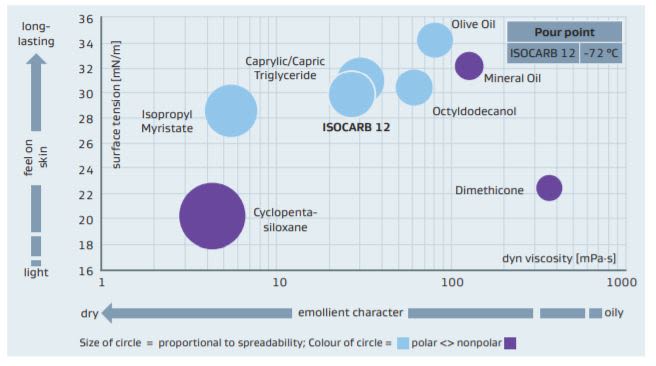
- Efficacy Studies
Lipid Composition of the Uropygial Gland Secretion of Asio Otus
The lipid composition of uropygial gland secretion of the long-eared owl (Asio otus) contains waxes of higher 2-alkyl-branched fatty acids, predominately 2-butyl-substituted fatty acids (55.6 %). These higher 2-alkyl-branched fatty acids are believed to contribute to the antimicrobial defense system of the avian plumage.
The antimicrobial efficacies have been evaluated of such higher 2-alkylbranched fatty acids obtained either from uropygial gland secretion or chemically synthesized. The most pronounced reduction in bacterial growth was observed with 2-butyloctanoic acid suppressing the growth of staphylococcus epidermis and corynebacterium xerosis below detection limit. It could be also demonstrated that chemically synthesized 2-butyloctanoic acid displayed antimicrobial performance similar to that of the acid isolated from nature.
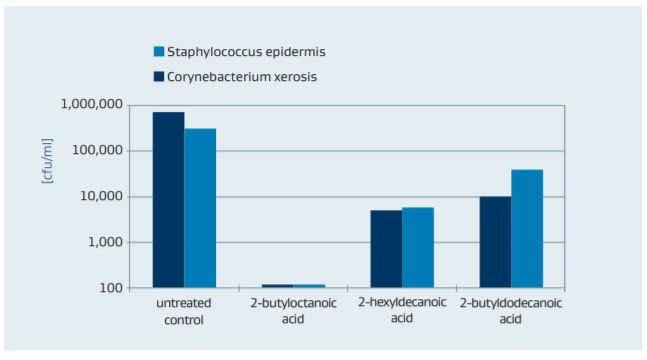
Study about the Prevention of Stress-Induced Sweating and Axillary Malodour Formation in Teenagers
The human axilla region is characterized by a dense arrangement of sebaceous, eccrine and apocrine sweat glands and provides an ideal humid and semi-occlusive environment for skin bacteria growth. The sweat secreted by the axillary glands contains various non-smelling precursor substances such as glutamine and steroids, which are biotransformed by lipophilic corynebacteria and staphylococci species into volatile, odorous substances such as 3-methyl-2-hexenoic acid and sulphanylalkanol.
During stressful situations in everyday life, the eccrine and apocrine sweat glands become activated, resulting in enhanced sweat secretion accompanied by a strong axillary odor and making it very unpleasant for the affected person.
Stinkless–Under stress
A study was conducted to investigate stress-induced sweating and malodour formation in teenagers who are known to experience stressful situations such as exams at school or job interviews. A test panel of 40 healthy adolescents (20 females and 20 males) aged 16 to 18 years participated in the Trier Social Stress Test (TSST), considered to be the most standardized and reliable test set-up to induce moderate psychosocial stress in a laboratory environment. The TSST induced high amounts of sweat and strong axillary malodour in this test panel of teenagers.
Specially developed to meet the needs of adolescent consumers, novel AP/Deo products (female and male AP aerosols) containing aluminum chlorohydrate (ACH) and 2-butyloctanoic acid (ISOCARB 12) were applied as AP/Deo active ingredients and parfume to mask sweat odor.
The study clearly showed that stress-induced axillary malodour among teenagers can be very effectively controlled by a combination of aluminum chlorohydrate (ACH), 2-butyloctanoic acid (ISOCARB 12) and parfume.
It was possible to reduce stress-induced sweat secretion under the challenging conditions of the Trier Social Stress Test (TSST) by 50 % regardless of gender, thus indicating that the tested formulations have a very strong antiperspirant effect.
Figure 3: Emotional sweating during Trier Social Stress Test (TSST)
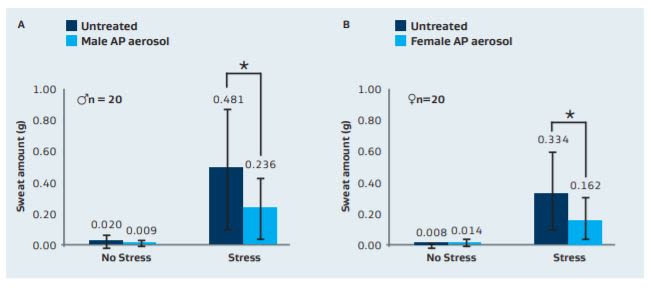
Asterisks indicate significant differences (P < 0.05)
In a comparison of male and female teenagers, the test results also showed significantly higher stress-induced axillary odor scores (2.79 versus 2.38) for male teenagers caused by increased apocrine sweat gland activity due to a higher testosterone level. After application of the aerosol formulation containing a combination of aluminum chlorohydrate (ACH), 2-butyloctanoic acid (ISOCARB 12) and parfume, a signifi cant decrease in malodour formation of 30% in male adolescents and 22% in female adolescents could be achieved.
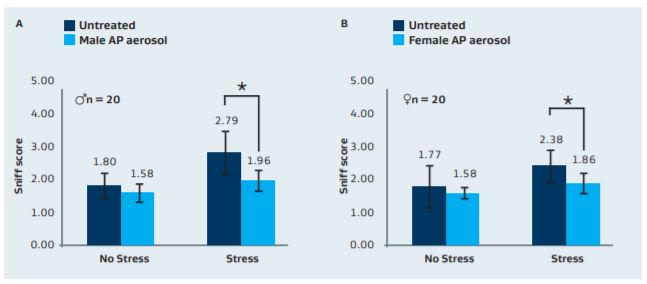
Asterisks indicate significant differences (P < 0.05)
- Viscosity And Density
Viscosity is a measure of a fluid’s ability to resist flow under gravity. The kinematic viscosity of a fluid is defined as the ratio of absolute or dynamic viscosity to its density. The viscosity of a fluid is highly temperature dependant. For a liquid the kinematic viscosity will decrease with higher temperature, for a gas the kinematic viscosity will increase with higher temperature.
ISOCARB acid viscosity vs temperature
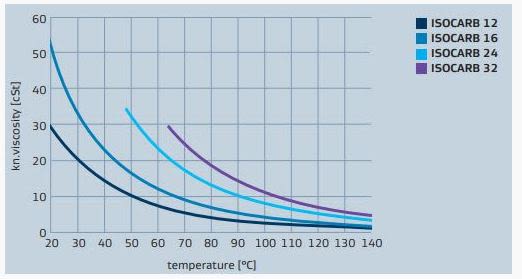
Density is a measure of how much mass is contained in a given unit volume. The formal definition of density is mass per unit volume. Usually the density is expressed in grams per ml. In general, density can be changed by changing either the pressure or the temperature. Increasing the pressure will always increase the density of a material. Increasing the temperature generally decreases the density, but there are notable exceptions to this generalization.
ISOCARB acid density vs temperature
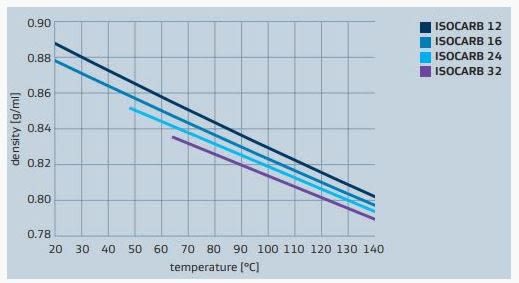
Packaging & Availability
- Country Availability
- Regional Availability
Storage & Handling
- Shelf Life
- 48 months
- Storage And Handling
Safe handling advice
- Take measures to prevent the build up of electrostatic charge.
Storage/Transport pressure
- Ambient
Load/Unload temperature
- Typically, 10-30°F above the melting point.